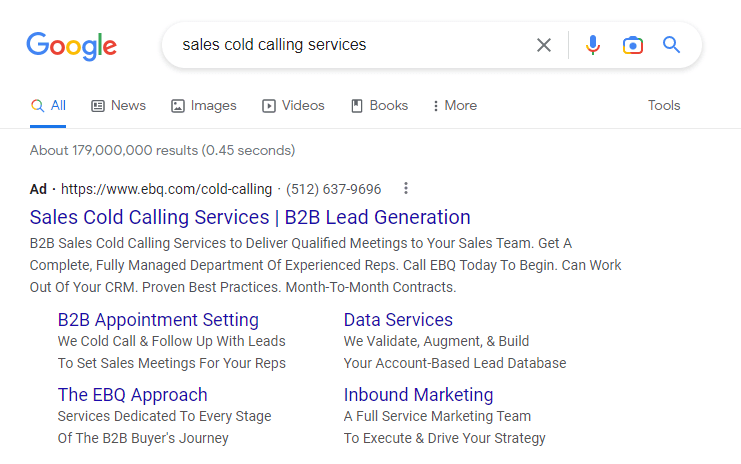B2B Google Ads Basics to Help You Get Started with PPC Campaigns


David Miedzianowski
Over the years, Google Ads has proven to be one of the most effective tools to generate B2B leads because your leads are already actively searching Google for solutions.
In fact, a study published by Google shows that the average B2B buyer conducts 12 different searches before even interacting with a website. From the same survey, 89% of B2B buyers are using the internet to gather more information about solutions during the research phase.
This means that gaining visibility on search engines is key to increasing leads.
In order to be successful, you need to leverage every aspect of search engine marketing — including both organic search engine optimization (SEO) and paid campaigns.

B2B Marketing Strategy Framework: The Ultimate Guide to Business Branding
Looking to create a strong B2B marketing strategy? This guide walks you through planning a data-driven marketing campaign.
In this post, you’ll discover why many B2B marketers are drawn to Google Ads. We’ll also explain Google Ads key terminology to help you get started on your first campaign.
First, let’s explore what Google Ads is.
What is Google Ads and how does it work?
Formerly known as Google AdWords, Google Ads is a pay-per-click (PPC) advertising tool to boost visibility on Google’s platforms — including Google search engine and YouTube.
So what are some differences between paid search advertising and organic search?
SEO vs. PPC
As mentioned earlier, search engine marketing involves both organic SEO and paid search in order to increase brand visibility on search engines.
While the art of SEO is all about driving organic traffic to your site, PPC includes paid results that can help you get in front of prospects based on the keywords you bid on.
So does PPC help with SEO? A paid search ad can improve your SEO score because it drives traffic to your site, signaling to search engines that the page is valuable.
To optimize their PPC budget, most B2B marketers choose to focus their paid search efforts on prospects near the bottom of the sales funnel. Since PPC can get exponentially expensive, it’s better to target those who are already actively searching for your type of solution. With a successful paid search campaign, you’ll be able to rank before organic results and outrank your competitors — helping you stay top of mind for those who already are most likely to purchase.

If you’re looking to strengthen your organic SEO strategy, be sure to check out our SEO checklist for blog posts. We cover everything from conducting keyword research to structuring your content properly for on-page SEO.
So if you already have a strong SEO strategy, why invest in Google Ads?
Does Google Ads work for B2B?
Studies show that traffic brought through PPC advertising yields an average of 50% more conversions than organic efforts. Of those PPC platforms, over 70% of paid search market share belongs to Google.
This means that concentrating on Google Ads can be effective for generating high-quality leads and boosting advertising ROI. In fact, a separate study has shown that the average ROI of Google Ads is 200%.
The key takeaway from all of these statistics? Investing in Google Ads can help your business get in front of those who matter most: your prospects.
One of the biggest challenges of using Google Ads is getting in front of the right searchers. Some things that can improve your chances are increasing your ad quality scores, targeting the right keywords, and creating highly relevant ads and landing pages.
Because PPC campaigns require a tech-savvy marketer, many businesses choose to outsource their digital marketing efforts. For example, EBQ’s digital marketers can help create high-converting paid ad campaigns and optimize ads over time using data-driven strategies.
Understanding the Google Ads account structure
Organizing and optimizing your Google Ads campaigns begins with understanding how Google Ad accounts are structured.
First, let’s review the hierarchy of a Google Ads account and define some key terminology.

- Account: Where all of your Google ads live. Typically, only one email address, password, and set of billing information will be associated for each account.
- Campaign: Consolidates ad groups together based on shared attributes — such as budget, location targeting, and messaging. For example, many B2B marketers often create separate campaigns dedicated to each product or service.
- Ad group: Groups of ads that share similar attributes, such as keywords, buyer personas, and even specific language about your solution.
- Keyword: Search terms you select for each ad group that are used to match your ads to the terms people search for. The cost-per-click (CPC) value differs depending on the keyword's competitiveness.
- Ad: The final ad that will be displayed to your searchers. This includes content such as headings, descriptions, images, and ad extensions.
It’s a best practice to set up only one account per website or app. This will make it easier for your team to track your ad performance.
While B2C organizations often opt for a multi-channel approach to Google Ads, most B2B organizations choose to focus their Google advertising efforts on text-based search ads. Since most B2B prospects search online for a solution to solve their pain points, search ads are typically the most effective way to capture these prospects’ attention.

Google Ads campaign overview
After reviewing the Google Ads account structure, take a moment to look over key Google Ads terminology before jumping into creating your first campaign.
- Campaign objective: Determines how Google will optimize and gauge the success of your campaign. There are 8 preset objectives to choose from, but B2B marketers typically focus on either “leads” or “traffic” as their objective depending on their goals.
- Campaign type: Specifies which type of ads your campaign will deliver. The most popular Google Ads types are Search and Display.
- Bidding: Establishes the monthly budget of your ad campaign and how to optimize your results based on conversions, conversion value, clicks, or impression share.
- Campaign settings: Further specify how and where your ads will be displayed based on your audience’s networks and locations.
- Ad extensions: Further personalize and draw attention to your ads by adding more details — such as a callout, a direct call function, or even a lead form. Extensions can be set up at the account, campaign, or ad group level.
Once you get a better understanding of the foundations of Google Ads, you’ll be ready to optimize your Google Ads investment to bring in high-quality leads.

B2B Marketing Strategy Framework: The Ultimate Guide to Business Branding
Looking to create a strong B2B marketing strategy? This guide walks you through planning a data-driven marketing campaign.
Wrapping up the Google Ads basics
When set up correctly, Google Ads are effective for helping your website get in front of the right searchers. However, we can’t emphasize enough the importance of mastering the Google Ads basics before planning your Google Ads campaign.
If you need help creating your ads and setting up your campaigns, EBQ’s digital marketers can help. We provide a complete marketing department at a fraction of the cost of hiring in-house marketers.
Our specialists can help develop your Google Ads strategy and create attention-grabbing content in order to optimize your ad spend. Check out our marketing services to learn more.

